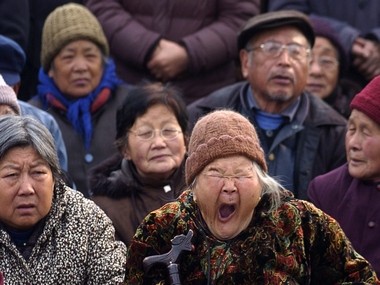Everyday across China, students and employees gather in schools, public squares or in their workplaces for a bit of exercise to martial tunes and drill instructions relayed over public address systems. It’s a ‘group callisthenics’ custom that dates back to the Mao Zedong era, which the Chinese revolutionary leader used as a vehicle to promote good public health - as well as loyalty to the Communist Party.
And although that ritual slowly faded out after Mao’s time, it has been revived in recent years because of the public health benefits that such group exercises were believed to bring.
These and other social investments in public health are one reason why life expectancy among the Chinese population has witnessed a dramatic improvement in the past 60 years. Indicatively, in 1965, Chinese men had a life expectancy of 54 years, and Chinese women of 55 years. The comparable figures for Indian men and women in the same year were 46 and 44 respectively.
Over time, life expectancy has improved in both countries, but China still fares considerably better than India. In 2006, for instance, the male and female life expectancy in China was 71.1 and 74.8 respectively; in India, it was 66.3 and 71.2.
The same is the case with education, particularly rural education and women’s education, where the social investments that were made during Mao’s time have over time led to dramatic improvements in literacy, particularly female literacy. That also means that many more women are employed in China than in India, which accounts for much of the labour productivity gains that Chinese workers have made.
And although the Mao era was also characterised by intense social turmoil during the Cultural Revolution from 1966 to 1976, even during that chaotic phase, the annual growth of real per capita GDP in China was on average 2.2 percent higher than in India.
Impact Shorts
More ShortsIn fact, in the estimation of political economist and MIT Sloan School of Management professor Yasheng Huang, it was the advantage of human capital, into which investments have been made since Mao’s time, that has enabled China to grow its economy at a fast clip over the past 30 years.
Mao’s lesson for India
[caption id=“attachment_84856” align=“alignleft” width=“380” caption=“By 2035, China’s population will skew heavily towards older age groups. Reuters”]
 [/caption]And if India can learn one lesson from China, he says, it is to make
similar investments in human capital
- in education, health and social infrastructure - rather than in attempting to match Shanghai’s famed skyline or building mammoth but unproductive infrastructure projects.
[/caption]And if India can learn one lesson from China, he says, it is to make
similar investments in human capital
- in education, health and social infrastructure - rather than in attempting to match Shanghai’s famed skyline or building mammoth but unproductive infrastructure projects.
A recent report from Rand Corporation , which analyses the demographics data relating to India and China too leads one to much the same conclusion.
Over the next few decades, it records, India will have a demographic advantage over China. Owing to China’s declining fertility, the average age of China’s population is today higher than India’s, and by 2035, China’s population will skew heavily towards older age groups, whereas the largest proportion of India’s population will still be below 50 and productive.
China also crossed another demographic milestone in 2010, which has negative consequences for future growth: its percentage of population that is of working age peaked at 73 percent and will decline to 60 percent by 2035. On the other hand, India’s working-age population as a share of the total population is gradually increasing - from 65 percent in 2010 to (an estimated) 68 percent in 2030.
But that “demographic dividend” will not count for much unless India can leverage it with investments in its human capital by improving its educational system, putting more girl children through schools and colleges, ensuring more women join the workforce, and improving the healthcare system.
“India has one of lowest female workforce participation rates in the world, and one of the least educated populations in Asia,” the report notes. Increasing educational attainment and women’s involvement in the workforce would give India’s economy an additional impetus for growth by expanding the labour force at a rate that exceeds the rate of population growth, while also improving its quality.
Venky Vembu attained his first Fifteen Minutes of Fame in 1984, on the threshold of his career, when paparazzi pictures of him with Maneka Gandhi were splashed in the world media under the mischievous tag ‘International Affairs’. But that’s a story he’s saving up for his memoirs… Over 25 years, Venky worked in The Indian Express, Frontline newsmagazine, Outlook Money and DNA, before joining FirstPost ahead of its launch. Additionally, he has been published, at various times, in, among other publications, The Times of India, Hindustan Times, Outlook, and Outlook Traveller.
)